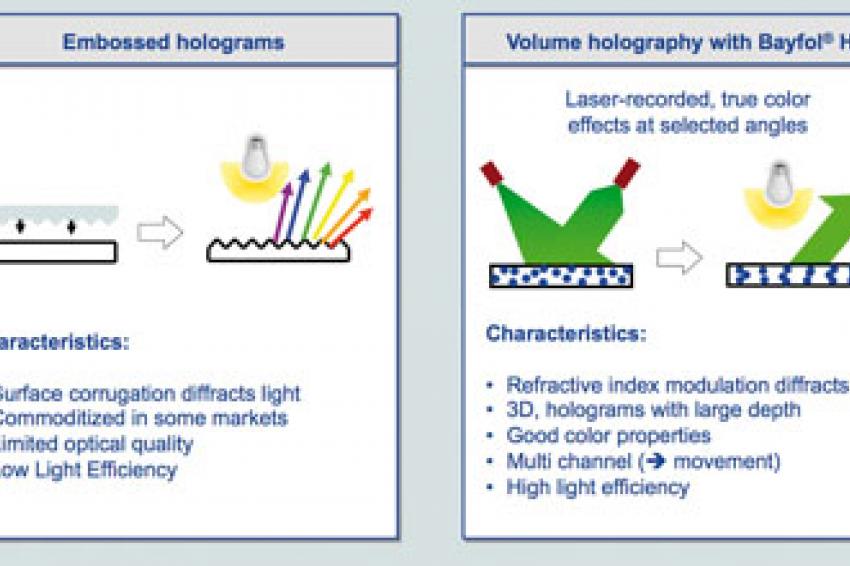Bayer MaterialScience Develops Photopolymer Films for Industrial Applications
16.02.2012 -
VIP - Visions In Plastics Holographic information can be "embedded" onto photopolymer films using laser beams. Bayer MaterialScience has developed films that are suitable for industrial production, which - unlike existing materials - do not require time-consuming subsequent treatment. A whole host of industries can benefit from the resulting high-performance holograms - from security technology and consumer electronics to the optical industry.
Holograms are made of structures roughly equal in size to the wavelength of visible light. They can be used to create fascinating optical effects and, because they can now be found on banknotes and EC cards, are part and parcel of our daily lives. These mass-produced visual features are usually made using special embossing technology (Fig. 1a). They create different visual effects depending on the angle at which they are viewed and can therefore be used as security features.
Tilting holograms to change the viewing angle alters the color of the object, creating a typical rainbow-effect color dispersion. This technology has been on the market for 25 years and is now considered relatively easy to copy and imitate.
Volume Holography
By contrast, volume holography supports very high resolution, a genuine 3D effect and bright, color-true reproduction (Fig. 1b). The mechanical embossing process is no longer used to produce such holograms. Instead, two interfering laser beams are used - the reference beam and the object beam. The interfering laser beams alter the refractive index of the holographic film - not just on one plane, but throughout the entire volume of the material, thus creating a spatial pattern. When white light later falls onto the holographic material, it diffracts off the pattern, revealing the embedded image or optical effect (Fig. 2).
Suitable for Mass Production
A factor that is key for the potential applications of volume holography is the availability of light-sensitive holographic materials that can be mass-produced. Bayer MaterialScience has conducted intensive research into such materials - known as photopolymers - in recent years. Its advances have led to a breakthrough for the widespread use of volume holography. It developed light-sensitive films, the first product variants of which are already market-ready under the name Bayfol HX. These films require no further treatment after the embedding process, thus facilitating the efficient production of volume holograms. What's more, they are characterized by low shrinkage, a long service life and good thermal stability.
Maximum Security And Aesthetics
Holograms based on Bayfol HX - such as those used in portraits, logos or stereograms - can help make identity cards and authentication more secure. They can be seamlessly combined with other established security features on identity cards (Fig. 3), documents or product packaging. Bayer MaterialScience distributes the Bayfol HX grades for security applications only to selected and certified manufacturers of holograms. Specialist knowledge would also be required to produce them.
Unlike traditional holograms, the background of volume holograms need not be metallic. Any background can be used. The color of the portrait or logo does not change depending on the angle at which it is viewed, meaning there is no rainbow effect. All in all, the volume hologram creates a high-quality optical effect, which makes it more appealing for use on ID cards, or products with authentication features. Used as a security feature, these holograms offer effective protection against product piracy.
Energy-efficient 3D Displays
Holographic Bayfol HX films could also be used in a whole host of other applications in the future. Developers at Bayer MaterialScience are working hand in hand with partner companies to develop components and devices that enable faithful color reproduction of 3D images and an accurate method of guiding light. They are confident that the films have the potential to become the leading material for light management in new technologies such as 3D displays or energy-efficient light technologies, e.g. LEDs. A panel of independent experts shared this opinion in 2009 when it awarded Bayer MaterialScience's research team, led by Dr. Friedrich-Karl Bruder, the North Rhine-Westphalia innovation award.
A characteristic feature of the holographic displays of the future is that they offer viewers a high-definition 3D experience without the need for special 3D glasses. What's more, they are energy-efficient with high contrast, even in daylight. The plethora of potential applications range from transparent advertising displays and daylight projection systems to 3D home cinema and TV screens.
Ready for New Applications
Thanks to the outstanding properties of Bayfol HX, this material can also be used to make holographic optical elements (HOE). These can, for instance, assume the optical functions of lenses or prisms with the advantage that they remain thin and lightweight over large effective areas, too. Even complex arrays of lenses and prisms can be replaced by a single HOE in a thin film.
Bayer MaterialScience is constantly evolving its holographic films in line with customer needs. In the field of security, it is working with selected partners with a view to covering the entire value-added chain for volume holography.







